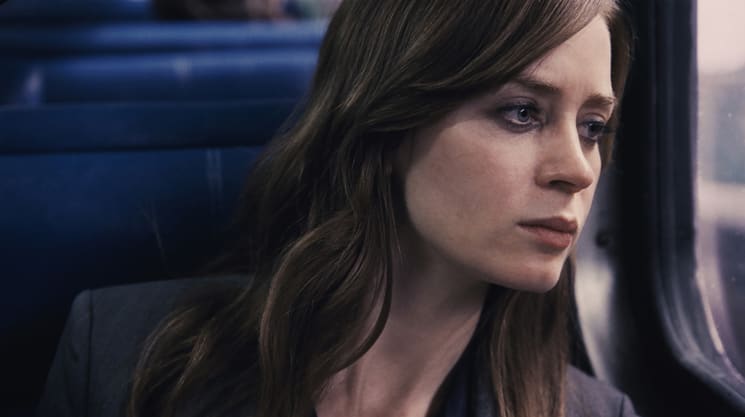Even before the first few film critics saw early screenings of American filmmaker Tate Taylor's adaptation of Paula Hawkins' novel The Girl on the Train, it seemed like most people had already come to the same conclusion: It looked like a crappy Gone Girl knock-off.
If you've seen posters for the movie, trailers or even have the slightest awareness of the British author's book and the mixed reactions that came with it, it's an easy (and excusable) assumption to make. Both stories deal with mysterious disappearances set in the suburbs; both films look vaguely Hitchcockian and sort of stylish (the former thanks to the skilled hand of director David Fincher); and both have the word "girl" featured prominently in the title.
If you're one of the people who helped boost the book to the top of the New York Times bestseller list in 2015, you already know what to expect here, but then same goes if you've spent any amount of time watching a thriller based on a piece of pulp fiction like this one. Although noted by some for its narrative complexity — The Girl on the Train's plot is told by three different points of view, all female (and one unreliable narrator) — it doesn't translate well to the silver screen. In fact, it's kind of a mess.
Rachel (Emily Blunt) is an alcoholic and divorcee who rides the same train going into Manhattan every day. During her daily commute, she stares out the window to get a glimpse of the house she used to live in and the life she led with her ex-husband, Tom (Justin Theroux), who is now remarried to Anna (Rebecca Ferguson). Two doors down is Megan (Haley Bennett), Anna and Tom's nanny to their one-year-old daughter, who lives with Scott (Luke Evans), an emotionally abusive husband. On the outside, it looks like they all have perfect lives. Deep down, there's a secret that connects them all.
When Megan suddenly disappears, Rachel believes the secret to her whereabouts lies in a foggy memory from one of her recent blackouts, but it seems like no one wants her to remember what that is.
Suspense is supposed to be the name of the game here, but Taylor has taken a story that wasn't that strong to begin with and made it as blandly watchable as he is blandly handsome; the sense of voyeurism so prevalent in the subgenre is there, but repeated voiceovers, excessive exposition and enough melodrama to fit into two movies strips The Girl on the Train of any nuance.
The characters aren't much better. Fans of the book praised its strong female characters, but on screen, they feel like stale archetypes: a cold and calculated sex kitten; a doting-yet-deceitful mother; a barren drunk. The men don't fare much better (both are physically abusive and one-dimensional). On paper, that should make Rachel's triumph at the end all the more meaningful. Instead, it feels as cheap as the pages its source material is printed on.
(Universal)If you've seen posters for the movie, trailers or even have the slightest awareness of the British author's book and the mixed reactions that came with it, it's an easy (and excusable) assumption to make. Both stories deal with mysterious disappearances set in the suburbs; both films look vaguely Hitchcockian and sort of stylish (the former thanks to the skilled hand of director David Fincher); and both have the word "girl" featured prominently in the title.
If you're one of the people who helped boost the book to the top of the New York Times bestseller list in 2015, you already know what to expect here, but then same goes if you've spent any amount of time watching a thriller based on a piece of pulp fiction like this one. Although noted by some for its narrative complexity — The Girl on the Train's plot is told by three different points of view, all female (and one unreliable narrator) — it doesn't translate well to the silver screen. In fact, it's kind of a mess.
Rachel (Emily Blunt) is an alcoholic and divorcee who rides the same train going into Manhattan every day. During her daily commute, she stares out the window to get a glimpse of the house she used to live in and the life she led with her ex-husband, Tom (Justin Theroux), who is now remarried to Anna (Rebecca Ferguson). Two doors down is Megan (Haley Bennett), Anna and Tom's nanny to their one-year-old daughter, who lives with Scott (Luke Evans), an emotionally abusive husband. On the outside, it looks like they all have perfect lives. Deep down, there's a secret that connects them all.
When Megan suddenly disappears, Rachel believes the secret to her whereabouts lies in a foggy memory from one of her recent blackouts, but it seems like no one wants her to remember what that is.
Suspense is supposed to be the name of the game here, but Taylor has taken a story that wasn't that strong to begin with and made it as blandly watchable as he is blandly handsome; the sense of voyeurism so prevalent in the subgenre is there, but repeated voiceovers, excessive exposition and enough melodrama to fit into two movies strips The Girl on the Train of any nuance.
The characters aren't much better. Fans of the book praised its strong female characters, but on screen, they feel like stale archetypes: a cold and calculated sex kitten; a doting-yet-deceitful mother; a barren drunk. The men don't fare much better (both are physically abusive and one-dimensional). On paper, that should make Rachel's triumph at the end all the more meaningful. Instead, it feels as cheap as the pages its source material is printed on.
